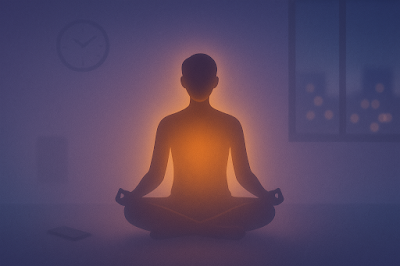Building a Strong Foundation: How to Create a Sustainable Yoga and Meditation Routine
Building a Strong Foundation: How to Create a Sustainable Yoga and Meditation Routine
Creating a consistent yoga and meditation routine can be transformative, but finding the balance to make it sustainable is key. With all the benefits these practices offer, it’s easy to feel pressured to dive in intensely—yet, that approach often leads to burnout. Instead, building a manageable routine that fits into your daily life can support long-term wellness and help you cultivate mindfulness, physical strength, and mental resilience without feeling overwhelmed.
In this guide, we’ll explore practical ways to integrate short yoga and meditation sessions into your day, discuss journaling prompts to help clarify your intentions, and share resources to support you on your journey.
Why a Sustainable Routine Matters
Establishing a balanced yoga and meditation practice allows you to experience the cumulative benefits of these practices, from enhanced mental clarity and emotional resilience to improved flexibility and physical strength. According to a study by the National Center for Complementary and Integrative Health, consistent yoga and meditation practices can reduce stress, enhance focus, and even improve sleep quality.
The goal of this routine isn’t to make you feel pressured to commit hours every day but to create a foundation that becomes a natural part of your life. For a deeper understanding of meditation’s mental and emotional benefits, check out my article, “Transcendental Meditation: A Comprehensive Guide to TM Technique and Benefits”.
Finding Balance: Start Small and Build Gradually
Many people find it helpful to start with just a few minutes a day, which is more manageable and helps prevent burnout. Begin with a simple 15-minute yoga flow in the morning and a 5-minute meditation in the evening. By setting realistic goals, you can gradually expand your practice over time.
In my article, “Yoga Poses to Wind Down: Evening Routines for Restful Sleep”, I explore how a short, calming session can help you unwind and transition into restful sleep, a concept you can incorporate into your daily routine.
Integrating Short Yoga Sessions into Daily Life
Yoga doesn’t have to be a long, intensive workout. In fact, short sessions can have profound effects on your physical and mental well-being.
Morning Routine: 15-Minute Yoga Flow
Start your day with a 15-minute yoga session that awakens the body and prepares your mind for the day ahead. This flow might include poses like:
- Cat-Cow: Warm up the spine and engage the core.
- Downward Dog: Stretch the hamstrings and open up the shoulders.
- Sun Salutations: Energize the body and connect breath with movement.
Not only does this brief routine help shake off any stiffness from sleep, but it also sets a positive tone for the day. Research published in the Journal of Occupational Health Psychology shows that even short yoga sessions can reduce stress and improve overall mood, making morning yoga a powerful tool to start your day on a positive note.
Evening Routine: 5-Minute Meditation for Stress Relief
Wind down at the end of the day with a 5-minute meditation. Find a quiet, comfortable spot, close your eyes, and focus on deep breathing to let go of the day’s stress. This short session can help you cultivate a sense of calm and prepare for a restful night. In my article, “Top 10 Yoga and Meditation Techniques for Stress Relief and Joy”, I provide additional techniques that help ease into relaxation, which you can explore to enhance your nightly routine.
Tips for Creating a Sustainable Routine
Making yoga and meditation part of your daily life is all about creating habits that fit seamlessly into your schedule. Here are a few tips to help you create a routine you can stick with:
Set Realistic Goals
It’s easy to get excited and want to practice every day, but setting manageable goals will help you build a sustainable habit. Aim to practice three to four times a week to start, and then increase frequency as it becomes more natural. Remember, quality is more important than quantity—doing a short, focused session is more beneficial than pushing through a long practice when you’re exhausted.
Find Your Ideal Practice Time
Consistency is easier when you choose a time that works well with your daily schedule. Reflect on these journaling prompts to help determine the best time for your practice:
- What time of day works best for your yoga/meditation practice?
- How can you adjust your schedule to prioritize self-care?
Experiment with different times to see when you feel the most engaged and energized. This personalization helps make the practice feel more natural and rewarding.
Listen to Your Body
One of the most important aspects of a sustainable routine is tuning into your own needs. There will be days when a short session feels more beneficial than an intense workout. Listening to your body helps prevent overexertion, reduces the risk of injury, and keeps you motivated to continue your practice.
The American Psychological Association (APA) emphasizes that mindfulness practices like yoga can help improve self-awareness, which allows individuals to make healthier choices and prevent burnout. Staying attuned to your needs ensures that your routine supports your well-being rather than becoming an additional source of stress.
Staying Motivated and Engaged
Maintaining motivation is often the biggest challenge in any new routine. Here are a few strategies to help keep you inspired:
Track Your Progress
Keep a journal to record how you feel before and after each session. Not only can this be motivating as you look back on your progress, but it also provides insight into the benefits you’re experiencing, which reinforces the habit.
Join a Community
Practicing yoga and meditation can be more enjoyable with the support of others. Consider joining a local yoga class or an online group where you can share your experiences and stay motivated. If you’re looking for resources or guidance, visit “harmonycentered.com”, where we have a supportive community and regularly share insights on building mindful routines.
Revisit and Adjust Your Routine
A sustainable yoga and meditation practice is one that evolves with you. Regularly check in with yourself to see if your current routine is still meeting your needs, and don’t be afraid to make adjustments. As your practice grows, you may want to explore other meditation styles, such as the techniques outlined in my article “First steps into silence: A Beginners Guide to Meditation”, which offers insights into deepening your meditation journey.
Conclusion
Building a sustainable yoga and meditation routine doesn’t have to be overwhelming. By setting realistic goals, integrating short, manageable sessions, and listening to your body, you can create a practice that supports your mental and physical well-being. Remember, consistency is more powerful than intensity. Even a 15-minute yoga flow in the morning and a 5-minute meditation at night can have profound effects on your life.
Explore more resources on “harmonycentered.com” to stay inspired, and feel free to revisit my articles on Transcendental Meditation and evening yoga routines as you continue your journey. Cultivate a foundation that will grow with you, one mindful breath at a time.








